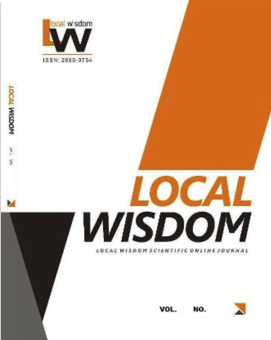The Role of Local Wisdom Values for Achieving Healthy Housing Concept in Humid Tropical Climate
DOI:
https://doi.org/10.26905/lw.v14i2.6774Keywords:
Local Wisdom, Healthy Housing, Tropical climateAbstract
Indonesia has a variety of vernacular architecture. The various of local wisdom values from Indonesian traditional houses have succeeded for local identity strengthening. On the other hand, residential housing currently prioritizes functional needs only, while aspects of formal characteristics and local wisdom values are not the main considerations in the design of today's residential housings. The role and characteristics of local wisdom values as an approach in residential design is certainly interesting to study more deeply. Descriptive analysis research method through field observation and literature study which was carried out as an effort to answer the research problem. The results show that the optimization of the passive design strategy of residential buildings by adapting local wisdom values is expected to increase indoor thermal comfort levels, achieve building energy efficiency, strengthen the urban identity, preserve architectural styles, also develop of sustainable architecture. In this way, healthy housing with local character can be realized throughout Indonesia.
Downloads
References
Azzmi, N. M. and Jamaludin, N. (2014). “A Review of Heat Transfer in Terraced Houses of Tropical Climateâ€, E3S Web of Conferences - Emerging Technology for Sustainable Development Congress (ETSDC), 3, 1-6.
Choi, K. and Yu, C. (2011). “Sustainable Design for Asian Housings: Traditional Culture, Lighting and Aestheticsâ€, Indoor Built Environtment, 20(5), 485–487.
Dincyurek, O., Mallick, F.H. and Numan, I. (2003). “Cultural and environmental values in the arcaded Mesaorian houses of Cyprusâ€, Building Environtment, 38, 1463–1473.
Hyde. R. (2000). Climate Responsive Design, New York: E & FN Spon.
Jamaludin, N., Khamidi, M. F., Wahab, S. N. A., and Klufallah, M. M. A. (2014). “Indoor Thermal Environment in Tropical Climate Residential Buildingâ€, E3S Web of Conferences - Emerging Technology for Sustainable Development Congress (ETSDC), 3, 1-6.
Kroner, W. (1997). “An Intelligent and Responsive Architectureâ€, Automation in Construction, 6, 381–93.
Lotfabadi, P., and Hancer, P. (2019). “A Compasrative Study of Traditional and Contemporary Building Envelope Construction Techniques in Terms of Thermal Comfort and Energy Efficiency in Hot and Humid Climatesâ€, Sustainability, 11, 1-22.
Mirrahimi, S. et al. (2016). “The Effect of Building Envelope on The Thermal Comfort and Energy Saving for High-Rise Buildings in Hot–Humid Climateâ€, Renewable and Sustainable Energy Reviews, 53, 1508–1519.
Sudikno, A. (2018). Arsitektur dalam Dinamika Ruang, Bentuk dan Budaya, Cahaya Atma Pustaka.
Suhendri and Koerniawan, M. D. (2017). “Investigation of Indonesian Traditional Houses through CFD Simulationâ€, IOP Conf. Series: Materials Science and Engineering, 180, 1-9.
Susilo, G. A., Umniati, B. S., and Pramitasari, P. H. (2019). Tipe dan Tata Masa Arsitektur Sasak di Pulau Lombok. Malang: Surya Pena Gemilang.
Zaki, W. R. M., Nawawi, A. H. and Sh. Ahmad, S. (2007). “Case Study in Passive Architecture: Energy Savings Benefit in A Detached House in Malaysiaâ€, Proceedings in the 24th Conference on Passive and Low Energy Architecture, University of Singapore, 259-266.
Zhu, Y., and Lin, B. (2004). “Sustainable Housing and Urban Construction in Chinaâ€, Energy and Buildings, 36(12), 1287–1297.












